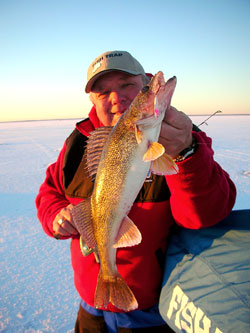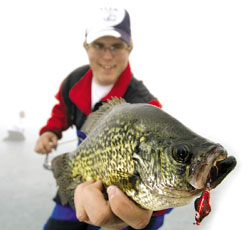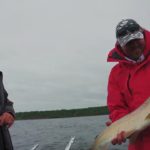Spoon-Feeding Winter Walleyes
 Fish slow down in cold water and a slow approach is often needed to catch them in the dead of winter. But it’s a different story at first ice– and in early spring, just before ice-out– according to Dave Genz, long considered the father of modern ice fishing. Walleyes are still hungry at early ice, when water is relatively warm and filled with oxygen, and they get excited as spawning time nears. Fast tactics like ice spoons are the ticket.
Fish slow down in cold water and a slow approach is often needed to catch them in the dead of winter. But it’s a different story at first ice– and in early spring, just before ice-out– according to Dave Genz, long considered the father of modern ice fishing. Walleyes are still hungry at early ice, when water is relatively warm and filled with oxygen, and they get excited as spawning time nears. Fast tactics like ice spoons are the ticket.
“At early ice, they’re still feeding up,” says Genz, a member of the Lindy Fishing Tackle pro team and captain of the Ice Team Power Sticks. “They slow down in January and February, but they become more aggressive again as the water warms near spring. Spoons seem to be much more effective then.”
Active early- and late-ice walleyes are drawn to a spoon’s flash in clear water. Some spoons, like Lindy’s new Rattl’n Flyer Spoon, add sound to their attraction, a big factor in the ‘golden hours’ before sunrise and just after sunset, times when walleyes, Genz explains, are on the move and looking for something to eat.
Sound also helps predators locate your bait in dark or dirty water or at night.
Genz believes the addition of sound to the spoon’s bag of tricks is as big a breakthrough as the introduction of Techni-Glo colors was just a few years ago.
“The golden hours in the evening for walleyes are excellent,” Genz said. “Walleyes are feeding, and spoons work the best. You work them, they are flashy, they rattle, and they’ll attract fish from a distance.”
Unlike other spoons, Lindy Flyers offer another compelling feature. Instead of simply falling straight down the hole, they glide away from it and sometimes land as much as three feet to the side. That fact allows ice anglers to “cast” in different directions and cover more water.
Once a spoon is on the bottom, Genz makes sure he drags it back beneath him rather than lifting it immediately. The dragging action can release morsels of food from the bottom into the water and call walleyes to feed.
“Things that live in the bottom are what walleyes feed on a lot of times,” he says. “Take your time. Stir up the bottom.”
The same theme is at work when he makes certain he hits the bottom to stir up the silt as he snap-jigs the spoon.
Genz uses low-stretch mono down to about 30 feet. In water deeper than 30 feet, he often switches to super-braid lines to improve feel. He doesn’t use a snap, tying the line directly to the lure. This setup forces him to check his knots for frays more frequently and retie more often. The extra care translates to fewer lost fish due to break-offs.
He also shuns barrel swivels, which some anglers use in-line to avoid twist. He doesn’t bother when he’s using Flyers. They flutter rather than spin, he said.

Tipping the Spoon or Jig
Forget minnows early and late in the winter. Three or four colored maggots or wax worms on each hook are enough to bring on a strike and they’re easier to carry.
If you’re a diehard minnow user, try minnow heads; they’re a good alternative.
For ice fishing purposes, put the hook through the hard portion of the head and then out the mouth. The bait will stay on better as you are snapping a spoon up and down or shaking it.
“If you want to use a rattle bait, you have to aggressively shake it,” explains Genz. “If you go slow, there’s no advantage. Make sure you’re consciously rattling the rattle. Take it out before you go fishing and shake it so you’re aware of what it takes (to create the noise).”
But, as in all fishing, spoon fishing through the ice isn’t all about the lure.
Location & Other Crucial Details
Where you shake that jig will always be the main key. Genz has a favorite place to target walleyes swimming under the ice, a spot others often overlook. He focuses on the sharpest shoreline break into the deepest part of a lake. Walleyes don’t have to move as far to feed, a perfect situation for a fish that wants to eat without working hard to do it. Conserving energy means survival to a fish, especially during the cold months.
Finding the right spot on the break is critical. What you’re looking for, most of the time, is the area between harder surface on the steep break and the soft-bottom muck. The transition area has a consistency that’s just right for burrowing insects, Genz said. Walleyes will be there, too.
GPS paired with mapping chips cut down the work.
“You know how deep the water is,” says Genz, “before you drill.”
Still, several holes are needed. Place them in a zigzag pattern on the break, and use your electronics, including sonar and an underwater camera like the Aqua-Vu, to pinpoint walleyes.
Genz homes in on mid-lake reefs when fishing larger bodies of water. Stay mobile. A portable ice-fishing shelter, like the Genz-designed Fish Trap or Clam, will help.
Flashers with color screens reveal when fish move closer to the bait. You can actually watch and see how they respond to the jigging action you’re using. Adjust until you find the one that works best at any given time. Expect that factor to change from day to day, even hour by hour.
The Rattl’n Flyer Spoon is available in three sizes: one-inch-long 1/8-ounce, 1¼-inch, 3/16-ounce, and 1 3/8-inch, ¼-ounce. Colors include Techni-Glo red, rainbow, perch, firetiger, gold shiner and silver shiner. All feature Bleeding Bait round-bend treble hooks, holographic finish with life-like scale pattern, and Techni-Glo eyes.
There are times Genz will switch to the Genz Worm, which he designed. He’ll add up to a dozen colored maggots to bulk it up.
“It’s a deadly way to catch walleyes all winter,” he says.
Genz will also switch to a smaller Frostee spoon when trying to catch crappies, perch or bluegills through the ice. Without rattles, he’ll pound the bait to get the treble to shake and give off sound.
Genz’s and Ice Team’s web sites have more tips and tricks for fishing hard water. Visit www.iceteam.com and www.davegenz.com.
Try fishing faster in early and late winter. Fish are aggressive, so you should be, too.
Spoons are the ticket.





